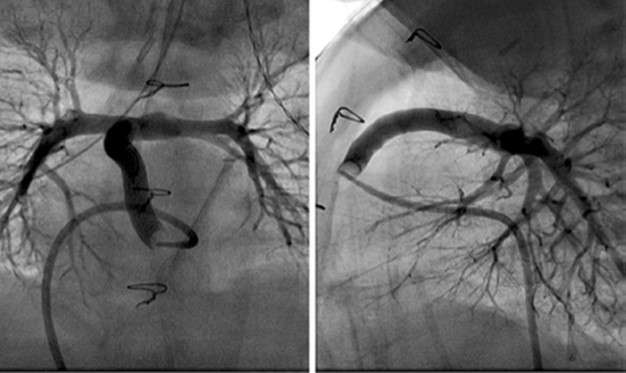A reinforced cylinder leads to fewer repeat surgeries for children born with heart defect

Hypoplastic left heart syndrome (HLHS) is a congenital defect in which the left side of the heart does not develop properly, impairing normal circulation. A series of surgeries can help restore heart function. A new study in the Journal of Thoracic and Cardiovascular Surgery, the official publication of the American Association for Thoracic Surgery, found use of a ring-reinforced cylinder instead of the usual non-reinforced conduit improved survival, reduced need for re-interventions, and induced physiological changes that may make patients better candidates for recovery after future surgeries.
"Although avoiding the use of a non-reinforced conduit may seem to be a minor adjustment in technique, the potential for important long-term patient benefit cannot be disregarded," stated Charles D. Fraser, Jr., MD, of Texas Children's Hospital (Houston) in an Editorial Commentary that accompanied the report. "While the journey toward staged HLHS palliation was begun several decades ago and there have been many steps, it remains an arduous journey. Even a small step of progress encourages further focus."
Normally, the right side of the heart pumps oxygen-poor blood from the heart to the lungs, while the left side of the heart pumps oxygen-rich blood throughout the rest of the body. In HLHS, the left side of the heart, including the ventricle, mitral and aortic valves, and ascending portion of the aorta are small and underdeveloped. Even with the right side of the heart assuming more than its normal workload, oxygenated blood cannot be properly circulated. Within a few days after birth, a baby with HLHS may develop shortness of breath, have a pounding heart and a weak pulse, and appear ashen or bluish in color, according to the Centers for Disease Control and Prevention.
While not a cure, a series of three surgeries are typically performed to help restore oxygenated blood flow to the body. The series of surgeries is called the Norwood Procedure following the first report of the operations in 1981 in this journal (JTCVS 1981: 82: 511-9). The first stage attempts to permit the normally functioning right ventricle to pump blood to both the lungs and the body. An important component of the current preferred version of the first stage is to connect a tube conduit from the right ventricle to the pulmonary arteries (the Sano shunt procedure). The second stage is known as the Bi-directional Glenn Shunt Procedure and follows when the infant is between four and six months old. The third step is the Fontan Procedure, which is carried out between 18 months to three years of age. Since only about 50% of children survive this three-part surgical series after five years, surgeons are always looking for ways to improve outcomes.
The report published in this month's Journal of Thoracic and Cardiovascular Surgery is a refinement of the Norwood Stage-1 surgery. In this retrospective review of 87 patients with HLHS who underwent Norwood Stage-1 surgery, 48 received the standard non-reinforced right-ventricle-to-pulmonary-artery (RV-PA) conduit with the tube made of Gore-Tex and 39 received the same conduit, but reinforced with rings. "The technique of using a ring-reinforced graft in conjunction with a limited right ventricular incision has theoretic advantages in preserving right ventricular function," explained lead investigator Audrey C. Marshall, MD, of the Department of Cardiology, Boston Children's Hospital, and Department of Pediatrics, Harvard Medical School (Boston). The ring-reinforced conduit maintains a uniform interior passageway for blood flow.
The findings were encouraging. For instance, survival to discharge after the first stage Norwood surgery was 98% in the ring-reinforced group compared with 83% in the non-reinforced group. In addition, survival at 12 months was higher in the ring-reinforced group (92% vs. 75%). Although cumulative death- and transplant-free survival at 12 months was higher in the reinforced ring group compared to the non-reinforced ring group, the differences did not reach statistical significance.
The investigators also found that patients with ring-reinforced grafts required fewer interventions, either to the shunt or the pulmonary arteries, in the first year compared to patients with non-reinforced grafts (40% vs. 69). "As others have observed, the use of a non-reinforced conduit is associated with a significant need for conduit re-intervention as a result of stenosis," noted Dr. Fraser.
The researchers found evidence that use of the ring-reinforced grafts improved pulmonary artery growth. The hope is that babies with larger and more mature branch pulmonary arteries will be better candidates for the second and third stage procedures (Bidirectional Glen and Fontan) which they will need in the future.
More information: "A reinforced right-ventricle-to-pulmonary-artery conduit for the stage-1 Norwood procedure improves pulmonary artery growth," by James R. Bentham, MD, PhD, Christopher W. Baird, MD, Diego P. Porras, MD, Rahul H. Rathod, MD, and Audrey C. Marshall, MD. DOI: dx.doi.org/10.1016/j.jtcvs.2015.02.046
Editorial Commentary: "The journey toward improved hypoplastic left heart syndrome outcomes continues—another small step," by Charles D. Fraser, Jr., MD. DOI: dx.doi.org/10.1016/j.jtcvs.2015.04.022
















